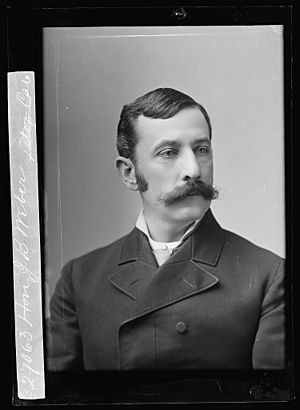John B. Weber facts for kids
Quick facts for kids
John B. Weber
|
|
|---|---|

John B. Weber
|
|
| Born | September 21, 1842 Buffalo, New York |
| Died | December 18, 1926 (aged 84) Lackawanna, New York |
| Buried |
Forest Lawn Cemetery in Buffalo, New York
|
| Allegiance | Union |
| Service/ |
|
| Years of service | August 7, 1861 - 1864 |
| Rank | |
| Unit | |
| Battles/wars | |
| Other work |
|
John Baptiste Weber (born September 21, 1842 – died December 18, 1926) was an important American leader from New York. He served as a U.S. Representative (a member of Congress) and later became the first Commissioner of Immigration at Ellis Island.
Contents
Early Life and Joining the Militia
John Weber was born in Buffalo, New York. His parents, Philippe Jacob and Mary Anne Weber, moved to the United States in 1833 from a place called Leutenheim in Alsace. John was the youngest of their four children.
He started school at Public School #4 when he was four years old. Later, he went to the Central School of Buffalo. Even while still in school, he began working as an "errand boy."
In 1856, when John was 14, he joined the New York State Militia. This was a group of trained citizens ready to help defend their state. He was a color guard in Company F of the 65th regiment. This meant he helped protect the flag.
Serving in the Civil War
John Weber joined the Civil War as a private on August 7, 1861. He was part of the Forty-fourth Regiment New York Volunteer Infantry. He quickly showed his skills.
By August 30, he was promoted to corporal. Then, on January 2, 1862, he became a sergeant. During the Battle of Yorktown on April 3, 1862, he was promoted again to sergeant major.
After serving in the Forty-fourth Regiment, John Weber became a first lieutenant. He was also appointed as an adjutant, which is like an administrative assistant to a commanding officer. During this time, he helped recruit soldiers for a new group, the One Hundred and Sixteenth New York regiment.
Leading the 89th United States Colored Infantry
On September 19, 1863, just two days before his 21st birthday, Weber became a colonel. He chose to lead the Eighty-ninth United States Colored Infantry. This was a regiment made up of African American soldiers.
The 89th regiment was formed in Port Hudson, Louisiana. It was also known as the "18th Infantry, Corps d'Afrique." In early 1864, during the Red River Campaign, most of his soldiers were moved to other units.
Colonel Weber was promised new soldiers from enslaved people who would be freed during the campaign. However, these replacements never arrived. He learned that his unit would be combined with another. Instead of waiting to be discharged, he resigned and returned home to Buffalo on July 8, 1864. The war ended before he could lead another command.
From Politics to Ellis Island
After the Civil War, Colonel Weber became involved in politics. He helped start a Republican club in 1867 and served as its president. This club supported General Ulysses S. Grant for president in 1868.
Weber also worked to change local election rules. These changes gave voters more say in choosing candidates for county offices.
He held several important jobs:
- Assistant postmaster of Buffalo from 1871 to 1873.
- Sheriff of Erie County from 1874 to 1876.
He also worked in the wholesale grocery business.
In 1884, John Weber was chosen as the Republican candidate for Congress. He was elected to the U.S. House of Representatives for two terms. He served from March 4, 1885, to March 3, 1889. He tried to be re-elected in 1888 but was not successful.
He was also a delegate at the Republican National Convention in Chicago in 1888. From 1888 to 1908, Weber served as the Grade-Crossing Commissioner for Buffalo. This job involved improving how roads and railways crossed each other.
First Commissioner of Ellis Island
In 1890, Weber was appointed as the very first Commissioner of Immigration at the Port of New York. This was a very important job.
On January 1, 1892, Ellis Island officially opened as the main immigration station. Colonel Weber greeted the first immigrant to pass inspection there, a 17-year-old girl named Annie Moore. He even gave her a $10 gold coin!
He held this position until 1893. Weber also served as the Commissioner General for the Pan-American Exposition in Buffalo in 1901. This was a big world's fair.
Later Life and Passing
John Weber passed away at his home in Lackawanna, New York, on December 18, 1926. He was 84 years old. He was buried at Forest Lawn Cemetery in Buffalo, New York. His grave marker says "Colonel 89th U.S. Infantry."
Honoring Colonel Weber
In Lackawanna, the local Veterans of Foreign Wars Post is named after Colonel Weber. This honors his service and leadership.
Images for kids


